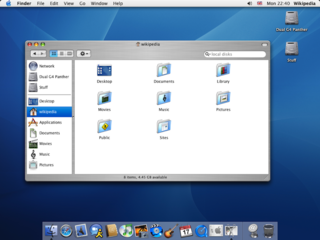An integrated development environment (IDE) is a software application that provides comprehensive facilities for software development. An IDE normally consists of at least a source-code editor, build automation tools, and a debugger. Some IDEs, such as NetBeans, JDoodle and Eclipse, contain the necessary compiler, interpreter, or both; others, such as SharpDevelop and Lazarus, do not.

The Power Macintosh, later Power Mac, is a family of personal computers designed, manufactured, and sold by Apple Computer, Inc as the core of the Macintosh brand from March 1994 until August 2006.
A network switch is networking hardware that connects devices on a computer network by using packet switching to receive and forward data to the destination device.

Mac OS X Server is a discontinued series of Unix-like server operating systems developed by Apple Inc. based on macOS. It provided server functionality and system administration tools, and tools to manage both macOS-based computers and iOS-based devices, network services such as a mail transfer agent, AFP and SMB servers, an LDAP server, and a domain name server, as well as server applications including a Web server, database, and calendar server.

Mac OS 9 is the ninth and final major release of Apple's classic Mac OS operating system which was succeeded by Mac OS X in 2001. Introduced on October 23, 1999, it was promoted by Apple as "The Best Internet Operating System Ever", highlighting Sherlock 2's Internet search capabilities, integration with Apple's free online services known as iTools and improved Open Transport networking. While Mac OS 9 lacks protected memory and full pre-emptive multitasking, lasting improvements include the introduction of an automated Software Update engine and support for multiple users.

The Power Mac G5 is a series of personal computers designed, manufactured, and sold by Apple Computer, Inc. from 2003 to 2006 as part of the Power Mac series. When introduced, it was the most powerful computer in Apple's Macintosh lineup, and was marketed by the company as the world's first 64-bit desktop computer. It was also the first desktop computer from Apple to use an anodized aluminum alloy enclosure, and one of only three computers in Apple's lineup to utilize the PowerPC 970 CPU, the others being the iMac G5 and the Xserve G5.
MorphOS is an AmigaOS-like computer operating system (OS). It is a mixed proprietary and open source OS produced for the Pegasos PowerPC (PPC) processor based computer, PowerUP accelerator equipped Amiga computers, and a series of Freescale development boards that use the Genesi firmware, including the Efika and mobileGT. Since MorphOS 2.4, Apple's Mac mini G4 is supported as well, and with the release of MorphOS 2.5 and MorphOS 2.6 the eMac and Power Mac G4 models are respectively supported. The release of MorphOS 3.2 added limited support for Power Mac G5. The core, based on the Quark microkernel, is proprietary, although several libraries and other parts are open source, such as the Ambient desktop.

The Xserve is a series of rack-mounted servers manufactured by Apple Inc. between 2002 and 2011. It was Apple's first rack-mounted server, and could function as a file server, web server or run high-performance computing applications in clusters – a dedicated cluster Xserve, the Xserve Cluster Node, without a video card and optical drives was also available. The first Xserve had a PowerPC G4 processor, replaced by a PowerPC G5 in 2004, and by Intel Xeon processors in 2006; each was available in single-processor and dual-processor configurations. The Xserve was discontinued in 2011, and replaced with the Mac Pro Server and the Mac Mini Server.

Mac OS X Panther is the fourth major release of macOS, Apple's desktop and server operating system. It followed Mac OS X Jaguar and preceded Mac OS X Tiger. It was released on October 24, 2003, with the retail price of US$129 for a single user and US$199 for a five user, family license.

The PowerPC 970, PowerPC 970FX, and PowerPC 970MP are 64-bit PowerPC processors from IBM introduced in 2002. When used in PowerPC-based Macintosh computers, Apple referred to them as the PowerPC G5.

The iMac G5 is an all-in-one personal computer that was designed, manufactured and sold by Apple Computer from August 2004 to March 2006. It is the final iMac to use a PowerPC processor, making it the last model that could natively run Mac OS 9 (Classic) applications.
The F-14's Central Air Data Computer, also abbreviated as CADC, computes altitude, vertical speed, air speed, and mach number from sensor inputs such as pitot and static pressure and temperature. Earlier air data computer systems were electromechanical computers, such as in the F-111. From 1968 to 1970, the first CADC to use custom digital integrated circuits was developed for the F-14.

In 2005 and 2006, Apple switched the CPUs of Mac and Xserve computers from PowerPC to the x86 architecture from Intel.

A phasor measurement unit (PMU) is a device used to estimate the magnitude and phase angle of an electrical phasor quantity in the electricity grid using a common time source for synchronization. Time synchronization is usually provided by GPS or IEEE 1588 Precision Time Protocol, which allows synchronized real-time measurements of multiple remote points on the grid. PMUs are capable of capturing samples from a waveform in quick succession and reconstructing the phasor quantity, made up of an angle measurement and a magnitude measurement. The resulting measurement is known as a synchrophasor. These time synchronized measurements are important because if the grid’s supply and demand are not perfectly matched, frequency imbalances can cause stress on the grid, which is a potential cause for power outages.
Eric Zelenka is a Senior Worldwide Product Line Marketing Manager at Apple Inc. Prior to working at Apple, Zelenka worked for StarNine Technologies, Quarterdeck Office Systems, DoubleClick, and Mandala Communications.
The Power Management Unit (PMU) is a microcontroller that governs power functions of digital platforms. This microchip has many similar components to the average computer, including firmware and software, memory, a CPU, input/output functions, timers to measure intervals of time, and analog to digital converters to measure the voltages of the main battery or power source of the computer. The PMU is one of the few items to remain active even when the computer is completely shut down, powered by the backup battery.

Aptana, Inc. is a company that makes web application development tools for use with a variety of programming languages. Aptana's main products include Aptana Studio, Aptana Cloud and Aptana Jaxer.
The System Management Controller (SMC) is a subsystem of Intel and Apple processor-based Macintosh computers. It is similar in function to the older SMU or PMU of non-Intel Macintosh computers.

Power management integrated circuits are integrated circuits for power management. Although PMIC refers to a wide range of chips, most include several DC/DC converters or their control part. A PMIC is often included in battery-operated devices and embedded devices to decrease the amount of space required.










